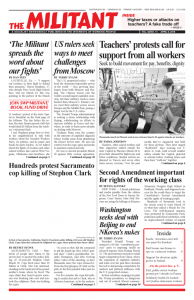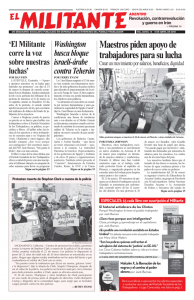NEW YORK — The 1911 fire at the Triangle Shirtwaist Company here is one of the country’s deadliest disasters for working people caused by the boss class’s disregard for safety and human life. As the flames began to leap over piles of cloth that littered the garment shop’s floor, the workers flocked to the narrow stairway leading to the single fire escape. It collapsed under their weight and workers plunged to their deaths. Others headed for the exit doors, but found them locked. The fire moved so fast that corpses of some were found still sitting in front of their machines. In less than 15 minutes that Saturday March 25 a total of 146 workers were killed.
“It’s important to remember what happened here out of respect for the workers who died and because it’s not a thing of the past, it’s still happening,” Don Weiner told the Militant at the March 23 commemoration of the fire outside the 10-story building that housed the Triangle shop on its three top floors. His aunt, Rosie Weiner, was one of those who didn’t survive. “At the commemoration a few years ago we talked about the workers who were killed in Bangladesh. For the same reasons, greed and dangerous workplaces.”
The bosses’ relentless drive for profits at all costs continues to maim and kill workers today — in construction, logging, coal mines, oil refineries, on the railroad, and everywhere line speeds are cranked up and up.
In their chase for cheap labor, garment bosses, retail capitalists and other factory owners have moved their production centers to Asia. And they’ve taken their disdain for workers’ health and safety with them.
In April 2013, more than 1,100 garment workers were killed when a building at Rana Plaza housing five garment factories collapsed in Dhaka, Bangladesh. The outer walls were cracked and at first workers refused to go in that day. When bosses threatened not to pay their wages, they went in. An hour later the building collapsed.
In two factory fires the previous year, one in Pakistan and one in Bangladesh, more than 400 workers died, the vast majority young women. The descriptions of what happened in both of them — and the bosses’ responsibility — are strikingly similar to those in the New York disaster.
Too few staircases, fire extinguishers that didn’t work, flammable stacks of yarn and clothes blocking parts of the stairs, iron-grilled windows. And bosses who locked exit doors.
“They said the workers at Triangle would steal material if they weren’t locked in,” Weiner said. “Aunt Rosie was 19 years old and had come here from Russia in 1902. He sister Katie, 16, was the last one to make it out alive.”
Young, immigrant, women workers
Triangle was then the largest shirtwaist manufacturer in the city, with 700 workers. Most of them were women in their teens and early 20s, immigrants from Italy, Russia and eastern Europe. They worked for subcontractors 13 hours a day, six days a week. Their average weekly pay was $6.
Most workers in the garment industry in Asia today are also young women, the first generation in countries like Bangladesh to join the industrial working class, working together in factories by the hundreds and thousands. And while they’re not immigrants, they are part of massive internal migrations where peasants move from rural areas and small towns to big cities and manufacturing slums.
Triangle was a nonunion shop, but some workers there were members of the International Ladies’ Garment Workers’ Union. In November 1909, the union called for a strike against Triangle and over the next few weeks it spread to other shirtwaist factories. The number of strikers swelled to over 20,000.
The bosses’ attempts to break the strike, including mass arrests and sending thugs to beat up workers, didn’t work. The strike won broad support among working people in the city and solidarity from the union movement. Coming out of the Triangle disaster the garment workers union won increasing support, with thousands of new members pouring in.
Kimberley Schiller, a teacher at the Finley Middle School in Huntington, Long Island, has brought her students to the annual Triangle commemoration since 2000. Every year she organizes them to learn about what happened.
“We read Ashes of Roses, a book about the disaster, and dig into the life of the workers,” she told the Militant. “My students can’t believe it happened.”
Schiller noticed the Militant’s front-page article on the West Virginia teachers strike and its connections to the struggles of mine workers there. The miners made a revolution in their union in the late 1960s and ’70s that made it possible for them to drive back deaths from black lung and gain control over safety in the mines. The bosses have driven the union out of many mines since and black lung is once again on the rise.
“Those teachers are awesome,” she said. “Working with the Triangle fire led me to learn about the 2010 Upper Big Branch Mine disaster in West Virginia. Did you know that Don Blankenship who ran that mine is running for senator? He’s responsible for 29 miners losing their lives, he should be in jail.”
The fight for workers control over safety conditions on the job remains just as critical today as it was 100 years ago.

